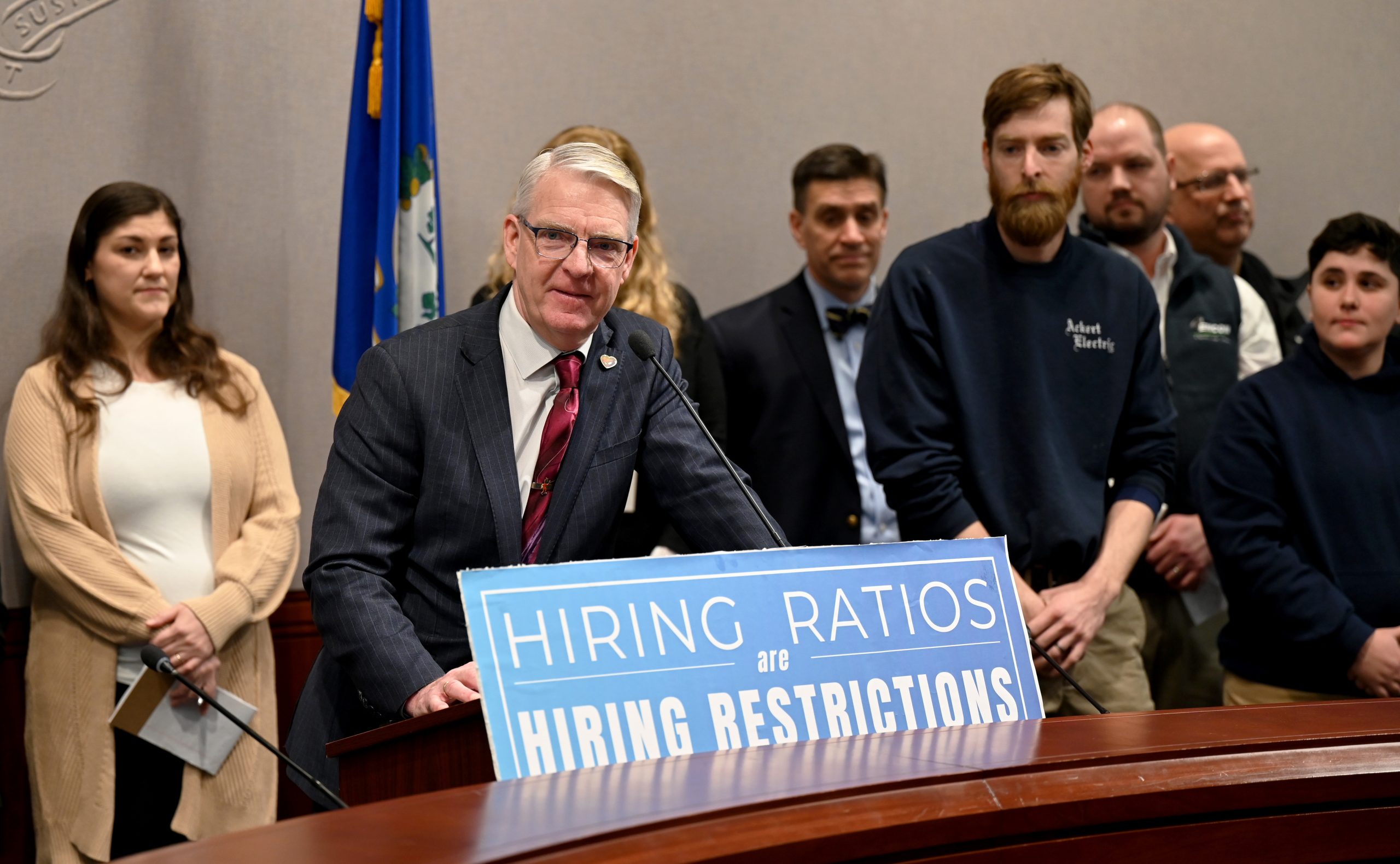**VIDEO** – Ackert Leads Calls to Amend Apprenticeship Hiring Ratios

Posted on February 15, 2024
(HARTFORD) – On Wednesday, State Representative Tim Ackert (R-Coventry) held a press conference calling for an amendment to state apprenticeship hiring ratios in certain construction trades. Ackert, who has been a licensed electrician for over 30 years, was joined by several skilled labor employers and employees that support changing hiring ratios in order to reinforce an aging workforce.
According to current law, which dates back to the late 1960s, the state mandates that each licensed apprenticeship sponsor must abide by a 1:3 (apprentice-to-licensed-contractor) ratio, after hiring their first three apprentices. This means that in order to hire one new apprentice, each employer must already employ three licensed contractors in that trade. The shared concern Wednesday was that this 1:3 ratio has limited the number of prospective apprentices from entering the workforce, threatening overall job growth amidst increasing demands for the installation of school heating and cooling systems, electric vehicle charging stations, and residential heat pumps.
“This is career suppression,” said Rep. Ackert. “Hiring ratios, simply put, are hiring restrictions. As an apprenticeship sponsor for three decades, I know firsthand how this has negatively impacted state job growth and our overall economy. If we want to successfully diversify and modernize our CT workforce, we need to begin by amending these ratios to expand career opportunities for all residents, developing our economy and labor pool.”
>> WATCH THE FULL PRESS CONFERENCE HERE <<
Allie French, Executive Director of the Independent Electrical Contractors of New England (IECNE), said, “We are behind the ball on replenishing the skilled labor workforce in Connecticut. Right now, roughly 20% of our apprentices are not working in an industry that desperately needs jobs filled. It’s time to make this simple change to help our employers, employees, create jobs, and ultimately strengthen our economy.”
Chris Cyr, Contractor of Dyna Electric, said, “When I came into the trades, I thought I was young. Now, at 39, I am still one of the youngest workers in my trade throughout the state. With rising retirement of current contractors, we need to expand opportunity in the trades for our youth, giving them a unique 1-on-1, learn-while-you-work career experience.”
Jennifer Jennings, Executive Director of the Connecticut Heating & Cooling Contractors Association (CHCCA), said, “Contractors will not be able to meet demands for installing cleaner energy alternatives, like solar or heating in our schools, unless we change this law. This industry offers vast opportunities, and with thousands of students grappling college debt, the trades can be a supportive alternative for our youth. Let’s promote the many benefits of the trades and get this law changed to help all prospective apprentices as they navigate their career paths.”
Stillman Jordan, P.E, President of Encon Heating & AC, said, “The contracting community is in significant pain. We have too much work and not enough workers. With new ideas are coming out of this building from indoor air quality control to generating more electric car charging stations. Who’s going to do the work? The simple truth is that this law, only in Connecticut, is restricting the number of people we can have to meet the needs of our state and residents. If we want a shot at more clean energy and job growth, change the ratios and promote the trades in our high schools to rebuild our workforce.”
Jim Perras, CEO of the Home Builders & Remodelers Association, said, “Housing production is low while demand has never been higher. We have had a depressed workforce since the ‘great recession’ on top of studies showing that 63,000 young adults are ‘disassociated from work or school’. Changing these ratios will act as the necessary step to put our state on track for labor growth and to give youth competitive career opportunities.”
Tim Schneider, Earthlight Technologies, said, “I began my career milking cows in Ellington before becoming an apprentice in the early 1980s. Today, our company has 25 electricians, with 8 apprentices. By amending the law, we could employ another 12 apprentices who are currently unable to make a positive career transition towards a better salary to support their families. We can’t continue to ask for waivers to hire new apprentices, many of which rarely succeed. We need to change this law now and stand with our youth.”
Joe Pollecchia, Retired Technical School Educator, said, “My responsibility as an educator was getting students jobs, but these ratios became my biggest challenge. Apprenticeships allow students to work, learn, and get paid, which both support students financially and sets them up for a lifetime career. Although pre-apprenticeship programs have helped slightly, they don’t solve the underlying issue which is establishing the next generation of trade workers in our state. It’s time to eliminate these restrictions.”
Rep. Ackert concluded, “Changing this law to reflect the regulated job site ratio of one licensed trade-person to one apprentice (1:1) will create hundreds of jobs. I think it’s unconscionable for this state to think it can meet its goals of affordable housing, school clean air requirements, and climate initiatives without increasing our trade workforce. Why do we continue to suppress careers in Connecticut? Let’s stop it.”
Rep. Ackert invites all supporters of amending current apprenticeship hiring ratios to contact their state legislators and the governor’s office to share their voice on this issue:
- Find your state legislator: www.cga.ct.gov
- Contact the Governor’s Office: (860) 566-4840
For additional questions or concerns about this or any state issue, please contact Rep. Ackert at Tim.Ackert@housegop.ct.gov or at 860-240-8700.